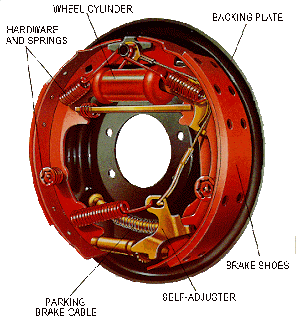Folks,
I'm out again today. Please begin work on your historical paper. If you have doubts as to whether or not I'll approve the paper, email me.
I expect to be back by Friday's class, and we'll do some work then. I believe all go-cart parts are in, and the Geely scooter stuff, too.
Thank you.
Sean
Park School Automotive Physics
Wednesday, December 12, 2012
Monday, December 10, 2012
Sean out today
Folks - I'm out today. Here's what you should be doing:
Revisit the sites below (particularly the 4-stroke engine ones). Watch the animation and be sure to read the howstuffworks pages.
Also, come to class on Wednesday with a potential historical topic for your final paper. Plan on this being a 5-7 page paper on a topic of automotive historical significance.
I hope to be back by Wednesday. Sorry to be out.
Revisit the sites below (particularly the 4-stroke engine ones). Watch the animation and be sure to read the howstuffworks pages.
Also, come to class on Wednesday with a potential historical topic for your final paper. Plan on this being a 5-7 page paper on a topic of automotive historical significance.
I hope to be back by Wednesday. Sorry to be out.
Monday, November 26, 2012
Engines vs. Motors
http://www.youtube.com/watch?v=FfTX88Sv4I8
http://www.youtube.com/watch?v=XVdZj2EDmhM
with labels
http://www.youtube.com/watch?v=aATDsYVVcRM&feature=fvwrel
http://www.animatedengines.com/otto.html
Otto Cycle
http://auto.howstuffworks.com/engine.htm
Alternate pages for the animation:
http://www.poetv.com/video.php?vid=8037
http://videosift.com/video/Animation-of-car-engine-assembly-and-operation
More info than you need:
http://en.wikipedia.org/wiki/Engine
Motors:
http://www.animations.physics.unsw.edu.au/jw/electricmotors.html
Friday, November 16, 2012
FYI
http://www.mopedcentral.com/forsale.html
For those of you looking to buy something - this guy buys and sells project mopeds.
For those of you looking to buy something - this guy buys and sells project mopeds.
Tuesday, November 13, 2012
Wednesday, November 7, 2012
Pascal's Principle - the secret of brakes
In general, most fluids are incompressible (or very slightly compressible). As a result, pressure applied to a fluid is transferred equally everywhere in the fluid. Recall the definition of pressure:
P = F / A
Pressure = force / area
The units could be psi (pounds per square inch), or (in SI units), newtons per square meter (also called a pascal, Pa).
Force (F1) is applied to the small piston (A1), yielding a certain pressure (P). This is transmitted to the secondary piston (A2). To keep the ratio (P) constant, the resulting force (F2) on the other piston must be proportionally larger. This can be used to lift large objects (auto lifts) or stop fast cars with the application of your feet.
FYI:
http://hyperphysics.phy-astr.gsu.edu/hbase/pasc.html
Related: Pascal's law
The change in pressure equals the density times g (9.8 m/s/s) times the change in vertical height - this is useful for determining the pressure difference between two very different altitudes.
Now about those brakes....
Imagine pushing on brakes.
Fluid is transferred through brake lines to either drums or discs:
http://hogantire.com/tcbrakes.htm
http://auto.howstuffworks.com/auto-parts/brakes/brake-types/brake.htm
Wednesday, October 31, 2012
More from today's class
The Bernoulli Principle:
The pressure in a "moving stream" of fluid is LESS than that of the surrounding fluid. Recall the demonstrations:
- blowing between the 2 soda cans
- the beach ball suspended by the air from the shop vac
- imagine putting your thumb over the nozzle from a garden hose
The last example relates to the "equation of continuity" -
A1 v1 = A2 v2
Meaning: As the area (of the tube) gets smaller, the speed of the fluid gets greater.
Videos for the carburetor:
http://www.youtube.com/watch?v=4MnOgR4_jaE
http://www.fz1-forum.com/forum/gen-i-garage-tech-help/13659-how-carburetor-works-short-animation.html
The pressure in a "moving stream" of fluid is LESS than that of the surrounding fluid. Recall the demonstrations:
- blowing between the 2 soda cans
- the beach ball suspended by the air from the shop vac
- imagine putting your thumb over the nozzle from a garden hose
The last example relates to the "equation of continuity" -
A1 v1 = A2 v2
Meaning: As the area (of the tube) gets smaller, the speed of the fluid gets greater.
Videos for the carburetor:
http://www.youtube.com/watch?v=4MnOgR4_jaE
http://www.fz1-forum.com/forum/gen-i-garage-tech-help/13659-how-carburetor-works-short-animation.html
Subscribe to:
Comments (Atom)



